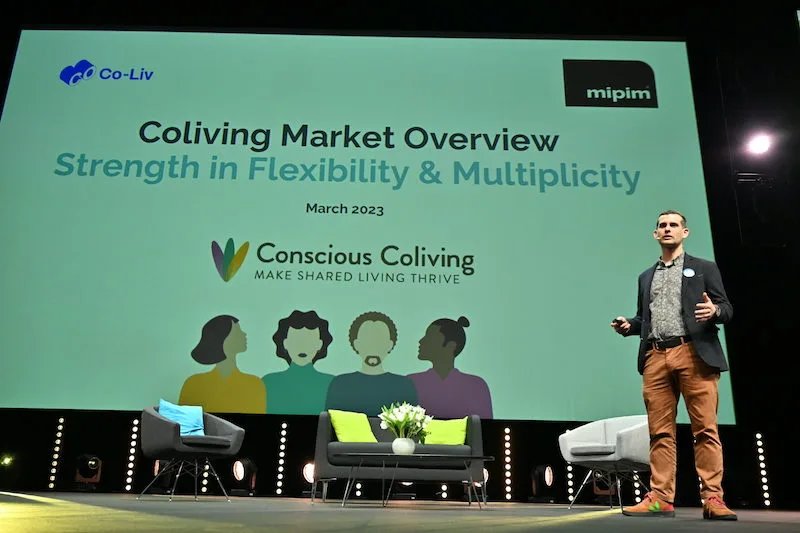In this article, we explore 3 highlights from this year’s edition of MIPIM, and the first ever MIPIM Co-Liv Summit, one of the year’s biggest coliving events which was held at the Palais des Festivals in Cannes in March 2023.
As one of the keynote speakers at the MIPIM Co-Liv Summit, I was in Cannes alongside leading players from the real estate and shared living industries. The article focuses on highlights from the MIPIM Co-Liv Summit and the latest insights and trends from the shared living industry.
MIPIM 2023
In crafting a unique urban festival / industry event during 4 days in Cannes, MIPIM influences and accelerates the transformation of the built environment.
Without a doubt, MIPIM is a catalyst for concrete solutions, combining face-to-face discussions, thought leadership, development opportunities and global capital to drive change in the real estate sector.
They connect and inspire the international real estate community to create more sustainable, liveable and prosperous places for all.
Most importantly, the energy was high as tens of thousands of real estate professionals in sunny Cannes to connect, exchange and inspire one another. MIPIM ended with the MIPIM Awards, which you can see the winners for here.
MIPIM Co-Liv Summit
Launched in partnership with Co-Liv, the leading global association of coliving professionals, the MIPIM Co-Liv Summit is a coliving industry event.
The event brought together the sector’s leading players to educate through sharing best practices and conference sessions on key trends, connect through networking events and ultimately empower the sector to deliver great places.
For this reason, MIPIM Co-Liv Summit was open to all coliving enthusiasts, investors, developers, operators, cities, architects and consultants.
The summit was organized in partnership with MIPIM by Co-Liv Director Gui Perdrix, Co-Liv COO Marta Rocamora Gonzalez, Co-Liv President Fabrice Simondi and a wider team of Co-Liv advisors.
In brief, the event lasted a half day and consisted panels and keynotes from Luca Bovone, Founder & CEO of Habyt, insights on investment criteria in coliving from JLL, Crosstree, Node and Greystar and an inspiring closing presentation about how architecture can help address systemic inequalities from CEO and co-founder of design studio Cutwork, Kelsea Crawford.
Below, I share some of my biggest learnings from the MIPIM Co-Liv Summit, including insights from the leading investors, operators, designers, service providers and more from around the shared living sector.
1 - Coliving is here to stay
Unquestionably, one of the biggest takeaways from this year’s MIPIM is that coliving is definitely here to stay!
For MIPIM to dedicate a full day of their yearly conference – it was established over 30 years ago in 1990 – to a summit consisting solely of coliving panels is a big indicator that shared living continues to be on the top of the agenda for the real estate industry.

Indeed, the curiosity surrounding the coliving model was strong, and players from a multitude of sectors – aviation, commercial real estate, tourism, public planning, journalism, design and beyond – came to the Co-Liv booth throughout the week asking about coliving and how to get involved.
What’s more, the lead article in the official MIPIM magazine highlighted the MIPIM Co-Liv Summit and the emerging trend. On the official MIPIM website, they described the interest as such:
” This new event responds to the rise of coliving, a form of residential development that provides shared living space for its residents. Coliving has the potential to address global issues around the shortage in housing many cities face by providing new, affordable lifestyle options for residents whilst providing dense, large-scale forms of living. “
In summary, for coliving to have such a strong presence at one of the world’s biggest real estate conferences really indicates it’s importance.
Furthermore, as it consolidates as a specialist real estate asset class, coliving / shared living in all its forms – senior coliving, student coliving, nomad coliving, large scale coliving, intergenerational coliving, etc. – is not only at the forefront of the real estate agenda but also a clear demand from a variety of consumers around the world.
2 - Coliving typologies are diverse and fragmented
One of the main sessions of the MIPIM Co-Liv Summit was the ‘Coliving Tour Showcase‘, facilitated by Co-Liv advisor Virginia Scapinelli.
This session was presented as a rapid fire showcase of 10 shared living operators from around the world. In particular, this was a chance for the audience to learn how different shared living typologies cater to a variety of consumer needs and see what sets each of these players apart in this fragmented market.
By and large, the main constant between these players was certainly their diversity and approaches to innovative flexible living model for modern consumers.
The operators ranged from French coliving and flatsharing operator Colonies, to co-owned entrepreneur houses with Circles, shared living for single parents with Commune, large scale purpose built shared living (PBSL) models with Node, LifeX’s tech-enabled, hassle-free living, UXCO’s 800+ unit student coliving community ECLA, Habyt’s high-growth, mergers and acquisition model, community-first coliving with Gravity and boutique shared living for expats in Switzerland with Ariv.
Indeed, if one thing is clear within the coliving sector it is that the sector has evolved over the years with a diversity of different typologies and players.
Coliving businesses typically operate with lease or management agreements, and sometimes more vertically integrated models as investors, developer, operators. In general, they have mostly catered to young professionals but their spaces and operational models come with all kinds of shapes, sizes, vibes and experiences.
As a result, consumers, investors and planners are sometimes scratching their heads about what coliving really means, and rightfully so. Therefore, this leads me to my next point, which has been an important one over the last few months and years within the coliving industry: industry standardisation.
3 - Industry standards & definitions are needed
Evidently, with all of the curiosity surrounding coliving at this year’s MIPIM edition, also came the question and confusion of ‘what is coliving‘?
To that end, this is a question we have been answering to a multitude of stakeholders for over 5 years now, through coliving research with the help of industry partners and peers like Co-Liv, Coliving Insights, Coliving Ventures and larger bodies like ULI.
Indeed, with diversity and fragmentation also comes confusion, and more and more when responding to this question we reply with the term shared living.
Shared living encompasses specialist real estate asset classes that blend residential, office and hospitality to create community and impact-driven live-work-play spaces. To illustrate, this can include hybrid hospitality, built to rent (BTR), student coliving / PBSA, PBSL, senior coliving, intergenerational living and more.
In summary, the short answer to the ‘what is coliving?’ question is that it is all of the above. The long answer involves a bit more complexity and comes down to the coliving business model, which is often referred to in comparison with real estate assets that are operated and structured similarly like PBSA, BTR and hospitality assets.
That said, we know that this education and awareness / standardisation is crucial for the next phase of the coliving industry’s growth, and you can reach out to us below to work with us if you’re looking for bespoke market research on these topics and more:
Keynote Presentation -
Coliving: Strength in its flexibility and multiplicity


Want to join future industry events?
Without a doubt, it is amazing to see so much innovation in the specialist real estate industry as the shared living sector evolves. We hope it fuels you in your journey ahead, either as an active participant of the creation and operations of coliving communities, or as a resident.
We certainly look forward to the next edition of MIPIM Co-Liv Summit. Until then, you can subscribe to receive Conscious Coliving email notifications for more resources and insights on coliving and updates on the future shared living events.
Finally, make sure to explore our podcast series, Coliving Conversations! 🎙️ 🏠 💚.
This article has been authored for you by:

Matt is responsible for designing community experience and impact strategies and measuring the social value of coliving communities. Matt is also a founding member and current Head of Community of Co-Liv and has worked for The Collective on their Impact Team.